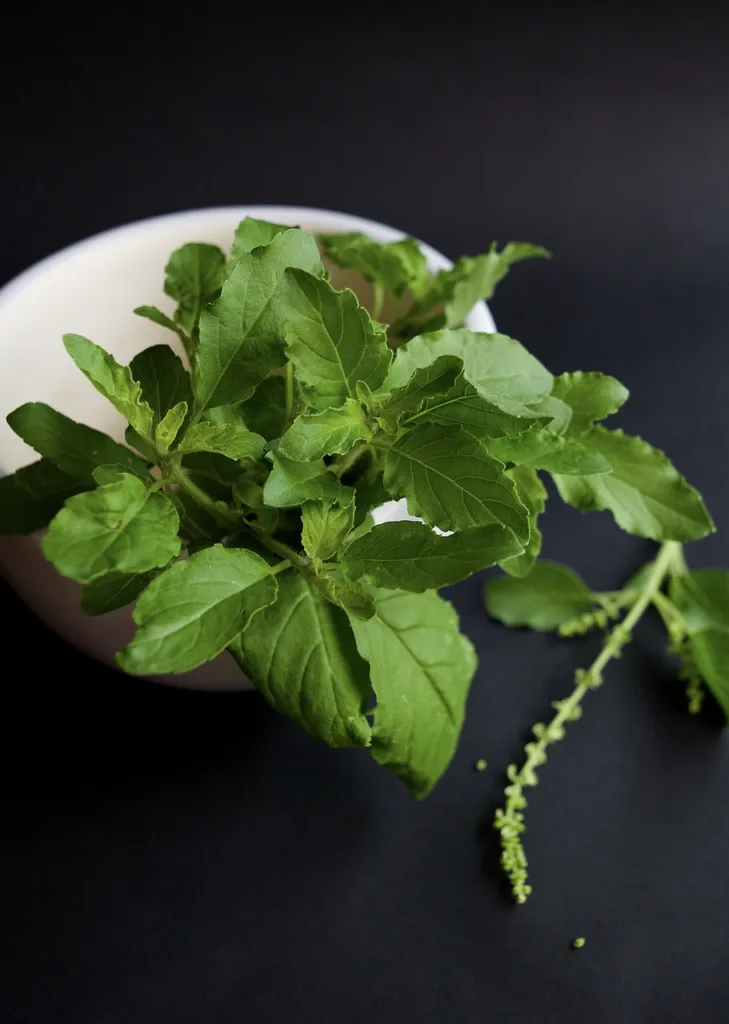Imagine a herb so revered that it’s considered sacred in an entire culture. Meet Holy Basil, or as it’s affectionately known in India, Tulsi. This isn’t your average garden variety basil. No, Tulsi is like the superhero of the herb world, steeped in ancient lore and packed with powers that can tackle everything from a pesky cough to stress that feels heavier than a sack of potatoes!
A Green Elixir for Good Health
Holy Basil has been the go-to herb for Ayurvedic practitioners for centuries, and for good reason. It’s like the Swiss Army knife of plants with a whole medley of health benefits. We’re talking about a natural stress-reliever, a digestion booster, and even a trusty ally for your immune system. This little green gem does it all.
Top 12 Health Benefits of Holy Basil

- Stress Alleviation Holy Basil is renowned for its adaptogenic properties, which significantly modulate stress responses and cortisol levels, thereby offering an effective remedy for stress management.
- Digestive Enhancement The herb is recognized for facilitating gastrointestinal function, promoting digestion, and alleviating various digestive disorders.
- Immunomodulatory Effects Holy Basil acts as an immunomodulator, bolstering the body’s defense mechanisms against pathogenic infections.
- Anti-inflammatory Properties Compounds within Holy Basil exhibit potent anti-inflammatory effects, contributing to the mitigation of inflammation-related conditions.
- Antioxidant Activity With a rich profile of phytochemicals, Holy Basil serves as a robust antioxidant, countering oxidative stress and contributing to cellular health and longevity.
- Cardiovascular Support The herb has been associated with cardiovascular benefits, supporting cardiac function and contributing to circulatory health.
- Glycemic Control Holy Basil aids in the regulation of blood glucose levels, making it a beneficial supplement for glycemic control.
- Anticarcinogenic Potential Research has indicated that Holy Basil may possess properties that inhibit the proliferation of cancer cells, suggesting a potential role in cancer prevention strategies.
- Dermatological and Trichological Benefits The purifying and antimicrobial properties of Holy Basil contribute to skin and hair health, enhancing complexion and hair vitality.
- Oral Health Holy Basil’s antimicrobial effects extend to oral health, where it may be used to maintain dental hygiene and prevent dental pathologies.
- Respiratory Function Improvement The herb’s influence on the respiratory system is marked by improved airway clearance and the mitigation of respiratory ailments.
- Detoxification Holy Basil supports the body’s detoxification processes, aiding in the elimination of toxins and promoting overall metabolic efficiency.
5 Easy Recipes Using Holy Basil

- Tulsi Tea To prepare a calming cup of Tulsi tea, steep dried Holy Basil leaves in boiling water for about 5 minutes. This tea can be enjoyed daily to harness the therapeutic benefits of Holy Basil.
- Tulsi Honey Lemonade For a refreshing twist, mix freshly squeezed lemon juice, water, and a teaspoon of honey with a handful of Holy Basil leaves. Serve chilled for a revitalizing summer drink.
- Tulsi-infused Water Infuse a jug of water with fresh Holy Basil leaves overnight. Drink throughout the day for a subtle, detoxifying beverage.
- Tulsi Smoothie Blend a cup of your preferred fruits with a small bunch of Holy Basil leaves, yogurt, and a teaspoon of honey. This Tulsi smoothie serves as a nutritious breakfast option or an afternoon pick-me-up.
- Tulsi Pesto Create a unique pesto by processing Holy Basil leaves, pine nuts, garlic, Parmesan cheese, and olive oil. This pesto can be used as a versatile condiment for pastas or as a delightful spread for sandwiches.
Tulsi Tea
Ingredients:
- 1 teaspoon dried Holy Basil leaves (or 1 tablespoon if using fresh leaves)
- 1 cup boiling water
- Optional: honey or lemon for flavor
Instructions:
Preparation of Leaves: Begin by measuring the Holy Basil leaves. If using fresh leaves, ensure they are thoroughly washed and free of any debris.
Steeping the Tea: Place the Holy Basil leaves in a tea infuser or directly into a cup. Pour boiling water over the leaves, ensuring they are fully submerged. Cover the cup with a lid or saucer to retain heat and allow the leaves to steep.
Infusion Time: Let the tea steep for about 5 minutes. For a stronger infusion, you may steep for up to 8 minutes. Be aware that a longer steeping time will intensify the flavor and therapeutic properties.
Final Touches: Remove the tea infuser or strain the leaves from the water if they were added directly. At this point, you may add honey or a squeeze of lemon to enhance the flavor profile according to your preference.
Serving: Serve the tea warm, and take a moment to inhale the aromatic fragrance before sipping. Enjoy the soothing and healthful qualities of the Holy Basil as you drink.
Note: Holy Basil tea can be consumed twice daily, in the morning and evening, to maximize its health benefits. It is advisable to consult with a healthcare provider before incorporating it regularly into your diet, especially if you are pregnant, nursing, or on any medications.
Tips for Growing and Harvesting Your Own Holy Basil

Cultivation:
- Choosing the Right Spot: Holy Basil thrives in sunny locations with good drainage. Select a spot that receives at least 6 hours of sunlight per day.
- Soil Preparation: The soil should be rich in organic matter, with a pH level ranging from 6 to 7.5. You can improve your soil with compost before planting.
- Planting: You can start Holy Basil from seeds or cuttings. Sow seeds in early spring, after the last frost, or plant cuttings directly into your prepared soil.
Care:
- Watering: Holy Basil prefers moist soil but is drought tolerant once established. Water the plants regularly, especially during dry spells, to keep the soil slightly damp.
- Fertilizing: Feed your Holy Basil plants with a balanced, all-purpose fertilizer every 4 to 6 weeks to support robust growth.
- Pruning: Regularly pinch off the tips of the plants to encourage bushy growth and prevent early flowering.
Harvesting:
- When to Harvest: The best time to harvest Holy Basil leaves is in the morning when the essential oils are strongest. Begin harvesting leaves once the plant is 6 to 8 inches tall.
- How to Harvest: Use scissors or your fingertips to gently remove leaves or branches. Always leave enough leaves on the plant to ensure continued growth.
Storage:
- Short-Term Storage: Fresh Holy Basil leaves can be stored in the refrigerator for a few days, wrapped in a damp paper towel and placed in a plastic bag.
- Long-Term Storage: For extended storage, Holy Basil can be dried or frozen. To dry, hang bunches of Holy Basil upside down in a warm, dry place away from direct sunlight. Once dry, crumble the leaves and store them in an airtight container.
By following these tips, you can ensure a healthy and productive Holy Basil plant that can provide leaves for your teas, recipes, and remedies.
Frequently Asked Questions (FAQs)
Holy Basil, or Tulsi, is distinct from other basil varieties in flavor, aroma, and therapeutic properties. It has a spicier, clove-like taste and is used for its health-promoting qualities rather than as a culinary herb.
While Holy Basil can be used in cooking, its flavor is quite different from that of sweet basil. It’s more commonly used in teas and medicinal preparations. If used in cooking, it imparts a more robust and earthy flavor to dishes.
There is no standard dosage for Holy Basil; however, drinking 1-2 cups of Holy Basil tea daily is commonly practiced.
Holy Basil is considered safe for most people when used in food amounts. However, medicinal amounts should be used with caution, as it may affect blood clotting and blood sugar levels. Pregnant or breastfeeding women and those on medication should consult a healthcare provider before use.




